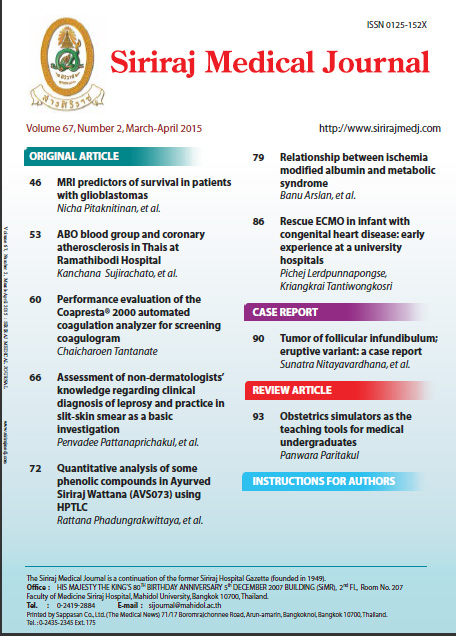Quantitative Analysis of Some Phenolic Compounds in Ayurved Siriraj Wattana (AVS073) Using HPTLC
Abstract
Ayurved Siriraj Wattana Recipe (AVS073) has long been used for healing in Thai traditional medicine treatment for health promotion, appetite inducement and retardation of health degeneration. The formula comprises 18 herbal components. Phenolic compounds are commonly found in different kinds of plants and show considerable pharmacological activities. Therefore, AVS073 and its 18 components were assessed for some presence of phenolic compounds. High performance thin layer chromatography (HPTLC) technique was used with the developing solvent mixture (hexane : ethyl acetate : acetic acid, 31:14:5). A mixture of caffeic acid, ferulic acid, gallic acid, kojic acid, p-coumaric acid and vanillic acid was used as a reference marker to identify the presence of individual phenolic compounds. By this method, caffeic acid and gallic acid were detected in AVS073 in the range of 0.0022-0.0065 and 0.0051-0.0058 % w/w, respectively. Of the 18 components of AVS073, the most commonly found phenolic acid was caffeic acid (0.0021 - 0.0695 % w/w). Gallic acid was detected in the highest amount in Ferula assa-foetida. However, ferulic acid, kojic acid and p-coumaric acid were found in some components, but not in AVS073. The chromatogram fingerprints of caffeic acid and gallic acid might be useful for the quality assessment of AVS073 production.
Keywords: High performance thin layer chromatography (HPTLC), fingerprint analysis, quantitative analysis, chromatographic fingerprinting
Downloads
Published
How to Cite
Issue
Section
License
Authors who publish with this journal agree to the following conditions:
Copyright Transfer
In submitting a manuscript, the authors acknowledge that the work will become the copyrighted property of Siriraj Medical Journal upon publication.
License
Articles are licensed under a Creative Commons Attribution-NonCommercial-NoDerivatives 4.0 International License (CC BY-NC-ND 4.0). This license allows for the sharing of the work for non-commercial purposes with proper attribution to the authors and the journal. However, it does not permit modifications or the creation of derivative works.
Sharing and Access
Authors are encouraged to share their article on their personal or institutional websites and through other non-commercial platforms. Doing so can increase readership and citations.










